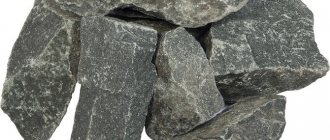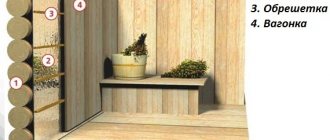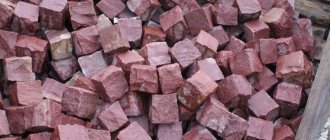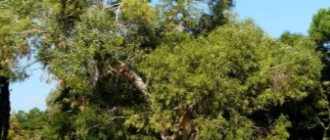This stone has another name - gabbrodorelite and is one of the most common natural stones, which fully meets the requirements of the 1998 State Standard for rock blocks for the production of facing, memorial, architectural, construction and other products. And if the finishing gabbro-diabase for a bathhouse needs to be decorated and polished, then the bulk one for a stove-heater is suitable in the state of stone fines directly from the face of the quarry. And in this form it will probably be the cheapest option for stone backfill. As they like to say at one well-known imported market: “It’s not cheaper, don’t look for it.”
Characteristics and properties of stone
Gabbro-diabase (or dorelite) is a volcanic rock that looks like granite or marble of uniform dark shades. It is characterized by high density and low moisture absorption. When heated, it expands evenly.
Physical properties of the stone:
- specific density - 3070 kg/cubic meter;
- frost resistance - at least 300 cycles;
- water absorption - 0.1%;
- compressive strength - 1400 kg/sq.cm;
- wear resistance during abrasion - 0.07 g/sq.cm;
- natural radioactive background - no more than 74 becquerels/kg.
In composition and properties, gabbro-diabase is close to basalt. It has the same fine-grained structure and igneous origin. It has a low silica content - the maximum value in the bulk does not exceed 53%.
In terms of the chemical composition, gabbro-diabase is practically indistinguishable from basalt - this is also magma of basic (alkaline) composition, which crystallized, but at a different depth. This circumstance is responsible for what crystals form in the stone. Gabbro-diabase basically consists of inert oxides that cannot be destroyed by bath temperatures, since they were formed at higher temperatures.
The chemical properties of gabbro-diabase for a bath are essentially indifferent, since they pose neither a threat nor benefit. But this does not apply to possible impurities in the form of sulfur, which is one of the components of liquid magma. As it cools, it “pulls” metals from the magma, forming sulfides. They, in the form of pyrite (iron sulfide), can crystallize inside the future gabbro-diabase.
Expert opinion
Lovkachev Boris Petrovich
Bath master who knows everything about steaming
It is sulfides that are impurities that can harm the health of the steamer. If there are stones in the heater with an admixture of sulfides, then with strong heating they will disintegrate, forming sulfur oxides, whose reaction with water forms acids. The presence and amount of sulfides depends on the composition of the magma in the particular area where the stone was mined.
The color of gabbro-diabase is dark gray and greenish-black. At the fracture, the color is lighter, and the polished stone acquires a rich, thick and deep dark tone due to refractive processes.
Due to its unique ophitic structure, gabbro-diabase has high thermal conductivity, which guarantees rapid and uniform heating of the stone mass.
Its heat capacity is at a fairly good level, which ensures good heat transfer from the heater after the end of the fire, as well as reliable steam generation when water is supplied in optimal portions.
For bath use, this is a very useful, if not key, property: the stone creates an ideal microclimate in the steam room. The mineral is resistant to high temperatures and durable.
Extraction of gabbrodolerites
The extraction of gabbrodolerite is associated with many features. One of the main aspects in mining is to ensure maximum safety of the extracted material. Currently, stone extraction is carried out in different ways; the most popular ones are presented below.
- A hole (deep hole) is drilled in the rock. Explosives are placed in the hole and an explosion is made. As a result of the explosion, blocks of various sizes break off from the rock.
- The next method is similar to the first. A hole is also drilled into granite, but instead of explosives, pressurized air is injected inside. As a result, the rock splits.
- Identical to the previous method, but only water is poured into the holes and then wooden pegs are driven in. The wood swells and the granite cracks in the direction of the drilled holes.
- Extraction using a stone cutter. The stone is extracted using special diamond wire sawing machines. Stone blocks are cut from solid wood. This method ensures the best quality of the extracted stone.
Varieties and places of production
Gabbro-diabase varies by type depending on its composition, origin and properties.
According to its composition, the stone can be divided into several groups:
- ordinary or olivine-free;
- dolerites or olivines;
- quartz.
Among these groups, the following types of stones are distinguished:
- saussurite;
- leucophyre;
- mica;
- low-colite.
Gabbro-diabase is mined on all continents, but the deposits are uneven in volume and quality of the mineral. The thickness of the lenses and rock layers varies from tens to several hundred meters.
The value of the mined stone also varies:
Karelian black gabbro-diabase is valued higher than the greenish-gray rock from the quarries of Crimea.
Australian stone is identical in quality to Karelian stone, but has a 3 times higher price.
In Ukrainian gabbro-diabase, iron oxides can be released - ordinary rust. You can smell it in the water evaporating from the stone. But just wash the stones in acid and the problem should disappear.
The largest diabase deposits are located in the following countries:
- Brazil;
- Great Britain;
- Argentina;
- Finland;
- India.
In Russia, the main suppliers of stone are:
- Crimea;
- Ural;
- Karelia;
- Altai;
- Eastern Siberia.
Areas of use
Due to its properties, the stone is highly in demand in various fields.
In Russia, 80% of this is the ritual sphere: monuments and landscaping of the surrounding area.
In second place are paving stones and street paving. Gabbro-diabase is capable of withstanding extreme loads. The coating made from it does not explode in cold weather and has negligible abrasion.
Used in interior solutions: countertops, steps, and other elements.
Environmentally friendly, with low background radiation and absolutely safe for indoor use.
Advantages and disadvantages
- The main advantages of gabbro-diabase for baths are high thermal conductivity combined with a very affordable price. The flattened shape is convenient for placing in the oven.
- One of the disadvantages is that it takes a long time to heat up. In addition, if this breed is exposed to too high temperatures, it begins to emit an unpleasant odor. Decoctions and herbal elixirs cannot be poured onto gabbro-diabase. A persistent soot immediately forms on the surface.
Reference! Advanced bath attendants complain about the simple and “flat” steam obtained from gabbro-diabase: it is not as voluminous and refined as from the same jadeite. There is no dispute about taste, but the attractive price of the mineral makes it a very good choice for inexperienced users and beginners.
History and origin
The appearance of powerful deposits of diabase, called traps, according to geologists, is caused by global changes in the depths of the planet. As a result of the processes, huge accumulations of magma approach the upper tier of the soil.
The largest deposit is located in Hindustan. Geologists say that the mineral appeared as a result of the release of magma to the surface of the earth after a collision with a huge meteorite.
The main deposits are formed in areas where volcanic lava and tuff are concentrated. Diabase is developed from sedimentary mountain deposits.
Selection rules
When choosing gabbro-diabase for use in a heater, pay attention to the following key points:
- At the fracture, the structure should be as fine-crystalline as possible. Large grains indicate low strength, and such a specimen will quickly collapse when heated.
- Examine the structure using a magnifying glass for microcracks. When heated, they will begin to rapidly increase in size until the stone turns into dust.
- The body of the mineral should not contain a large number of inclusions of quartz. If this is observed, you are offered not gabbro-diabase, but some other rock.
- When struck, the stone should respond with a clear, transparent and elastic sound. A dull, annoying echo indicates the presence of hidden defects in the thickness.
- Form. In a closed heater, rounded stones will behave better, because there is always a little space between them, enough for water to flow inside. In the open, split gabbro-diabase is preferred for more dense installation.
- Many varieties of gabbro-diabase contain increased amounts of sulfides. Visually, they look like a scattering of small crystals with a mirror-like silvery or less often golden sheen. When heated, sulfides will break down and release a pungent odor, which will cause a sore throat and stinging in the eyes. The decomposition of sulfides can take quite a long time, so such a stone should be discarded.
- To test for strength, knock 2 stones together or hit them with a hammer. There is another indicative way to check the suitability of a stone. Heat it until red hot and immediately plunge it into cold water. If cracks or splits do not appear, you can safely use the stone in steam rooms and baths.
- Availability of a certificate. You should not collect any stones yourself in unverified places, near railways or in close proximity to industrial facilities. The stone tends to absorb various microparticles and odors, which can subsequently affect the quality of the supplied steam, and in some cases even pose a health hazard.
For your information! Domestic varieties of gabbro-diabase fully meet the basic requirements of a bath attendant and at the same time have an affordable price. The purchase of a more expensive Finnish stone is justified only by a better selection of stone and the absence of harmful sulfites in its array, which is often the case with Karelian analogues.
For the sauna: choosing a shape
In the sauna, as already mentioned, the stones are in plain sight, but are of little use for producing “light steam”.
In a Russian bath it’s the other way around—they’re not visible, but the shape partly affects what kind of steam you get.
On the other hand, you can find only two types of stones on sale: rounded and chipped. Let's consider both.
Chipped
Gabbro-diabase sauna stones, crushed. Photo by Leroy Merlin
Crushed stone is the result of crushing (read about methods of extraction, processing and use of gabbro-diabase here). Such a stone will inevitably have some cracking, which may affect its service life.
Split gabbro-diabase has sharp edges and any aspect ratio - it can be elongated, flattened, or vice versa. Its laying turns out to be more dense. And the surface, due to irregularities, is larger than that of a plane of the same size.
More dense laying is good in a grid or in an open heater . But in a closed heater it is better to leave a small space so that the water flows inside and reaches the hottest stones.
As a sauna stone, crushed gabbro-diabase can be chosen purely for its appearance , giving the interior more naturalness and “wildness”. In this case, it should be considered as a design element.
Rounded stones: bunded or tumbled
Polished gabbro-diabase. Photo Green Time
In nature, rounded stones appear in glaciers or rivers. In both cases, they travel a long distance, colliding with their own kind, which knocks off the sharp edges and rounds them. A person achieves the same by placing a stone in a drum and causing it to spin. If abrasives are added, you can even polish the surface.
Bounded is rounded. Tumbled is rounded with a smoother surface. In principle, both terms can be used; in relation to bath stones, the difference is not particularly noticeable.
In a closed heater , rounded stones of gabbro-diabase or any other would be better. Because there is always a little space left between them, enough for water to flow inside.
As for the open heater, you should focus on your taste or the taste of the designer if he chooses rounded stones to decorate the stove.
How to use gabbro-diabase in a bath
The combination of high thermal conductivity and low price determines the popularity and widespread use of gabbro-diabase in sauna stoves:
- The stone can be placed in the form of a combined backfill. Gabbro-diabase is placed at the point of contact with the hottest part of the furnace, and jadeite is placed on top as the finishing layer.
- In static heaters, the mineral can be used to fill the most stressed areas in terms of thermal load. The destruction of a large fraction will allow you to replace the stone with a new one without serious financial costs.
- It is very useful to use gabbro-diabase in flow-type heaters. The structure of the surface will make it easy to clean it from soot deposits, and after they become irremovable, replace the backfill with a new one.
- Caring for gabbro-diabase is simple. It is enough to wash it a couple of times a year - this will remove the unwanted smell. It is better to immediately remove specimens with cracks from the heater. You need to sort out the backfill at least once a year, and if you use the bathhouse very actively, once every six months. Cracked stones reduce heat transfer several times.
For your information! The reliable operation of gabbro-diabase in a continuous backfill will be enough for 2 seasons. On the third day, you should take care of restoring the stone basket with a complete replacement.
Common Questions
Is it possible to mix gabrodiabase with another stone?
It is possible, but soap chloride in this case will slightly reduce its heating.
I bought gabrodiabase, six months later I went into the heater, and there was sand and small crushed stone. What does it mean?
This happens when there is excessive overheating and active watering. This may also indicate low quality stone.
I put gabro-diabase in the heater, and it emits a rather pungent smell of sulfides. They are not visible from the outside. Is it possible to somehow remove these impurities?
When selecting and purchasing, special attention is required to stones that are brought from Karelia. They are completely “impregnated” with sulfides. Carry out 3 – 4 idle fires at high temperatures. If the smell persists, the stone will have to be removed from the heater and used for other purposes.
Is it possible to use gabbro-diabase with a red coating that appears on wet stone?
Red plaque is usually iron oxides on the surface of the stone; they are harmless. But too many red-brown spots may indicate that we have pyroxene or hornblende.
I was going through my heater and found a whitish coating on the gabbro-diabase, which is difficult to remove. Isn't this dangerous?
A dense whitish coating is the release of carbonate rock under the influence of water. It is safe for health and should not be considered as a stone defect.
Are there any contraindications to the use of gabbro-diabase in a bath?
The concept of “contraindications” is medical and is associated with the healing benefits of stones. In the bathhouse, they play exclusively the role of heat accumulation and transfer. In this sense, it is contraindicated to use, for example, marble or granite, because they will not withstand periodic heating and cooling. The heart and blood vessels are much more influenced by the ratio of temperature and humidity in the steam room than by the type of stones in the oven. So don’t complicate what’s simple and calmly put high-quality gabbro-diabase into the heater; it has absolutely neutral effects on the human body.
Bath and sauna: how do they differ in terms of stones?
In order to take this point of view, it is not at all necessary to become a stone











